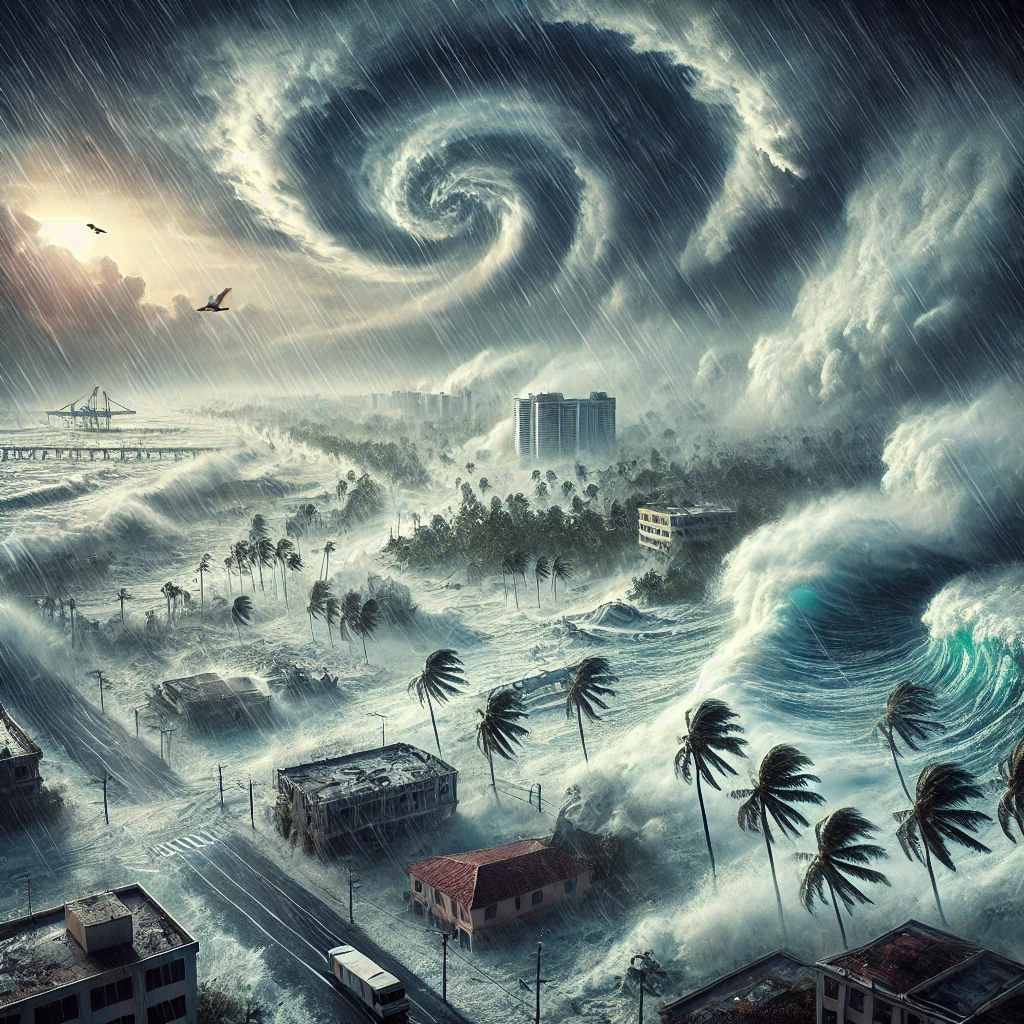Tropical cyclones, also known as hurricanes or typhoons depending on their location, are among the most powerful and destructive natural phenomena on Earth. These intense storms can cause widespread devastation, bringing torrential rain, powerful winds, and severe flooding to the regions they impact. As climate change continues to affect global weather patterns, the frequency and intensity of tropical cyclones are also changing, making it crucial to stay informed about these powerful storms. In this article, we will explore the science behind tropical cyclones, examine recent news and developments, and discuss the global impact of these formidable weather events.
1. What is a Tropical Cyclone?
A tropical cyclone is a rotating, organized system of clouds and thunderstorms that originates over tropical or subtropical waters. These storms are characterized by low atmospheric pressure, strong winds, and heavy rainfall. Depending on their location, tropical cyclones are known by different names:
– Hurricanes: Occur in the North Atlantic, central and eastern North Pacific, and South Pacific oceans.
– Typhoons: Occur in the Northwest Pacific Ocean.
– Cyclones: Occur in the South Pacific and Indian Ocean.
The formation of a tropical cyclone requires several key ingredients: warm ocean water (at least 26.5°C or 80°F), moist air, and a pre-existing weather disturbance. These conditions allow the storm to draw energy from the warm water and organize into a powerful, rotating system.
Tropical cyclones are classified into categories based on their maximum sustained wind speeds:
– Tropical Depression: Wind speeds of up to 38 mph (61 km/h).
– Tropical Storm: Wind speeds of 39 to 73 mph (62 to 118 km/h).
– Hurricane/Typhoon/Cyclone: Wind speeds of 74 mph (119 km/h) or higher, further categorized into five levels on the Saffir-Simpson Hurricane Wind Scale.
2. Recent Developments in Tropical Cyclone News
The 2024 tropical cyclone season has been particularly active, with several significant storms making headlines around the world. Let’s take a look at some of the most notable recent developments.
Hurricane Ida: A Devastating Impact on the Gulf Coast
One of the most powerful storms in recent memory, Hurricane Ida made landfall in Louisiana in late August 2024 as a Category 4 hurricane. With sustained winds of 150 mph (240 km/h), Ida caused widespread destruction, particularly in the New Orleans metropolitan area. The storm surge, combined with torrential rainfall, led to catastrophic flooding, displacing thousands of residents and causing billions of dollars in damage.
In the aftermath of Hurricane Ida, the resilience of the Gulf Coast’s infrastructure has been a major topic of discussion. While levees and flood control systems held up better than during Hurricane Katrina in 2005, the scale of the destruction underscored the ongoing vulnerability of coastal communities to powerful tropical cyclones.
Typhoon Haikui: Asia’s Struggle with Intense Storms
In the Western Pacific, Typhoon Haikui became one of the strongest storms of the 2024 season, impacting several countries, including the Philippines, Taiwan, and China. Haikui reached super typhoon status, with sustained winds exceeding 160 mph (257 km/h). The storm caused widespread damage, particularly in the Philippines, where it triggered landslides, severe flooding, and forced the evacuation of tens of thousands of people.
The frequency of intense typhoons like Haikui in the Western Pacific has raised concerns about the region’s preparedness for such events. With climate change expected to increase the intensity of tropical cyclones in the future, governments and communities are being urged to invest in more robust infrastructure and disaster response systems.
Cyclone Mandous: A Record-Breaking Storm in the Indian Ocean
In the Indian Ocean, Cyclone Mandous set a new record as one of the strongest cyclones to ever form in the region. Mandous reached Category 5 status, with wind speeds exceeding 180 mph (290 km/h). The storm primarily impacted Madagascar and parts of East Africa, causing widespread devastation. The combination of powerful winds, heavy rainfall, and storm surge led to significant loss of life and destruction of property.
The increasing intensity of cyclones in the Indian Ocean has been linked to rising sea surface temperatures, a direct consequence of global warming. Scientists are closely monitoring these changes, as the region is highly vulnerable to the impacts of climate change.
Hurricane Javier: A Rare Late-Season Threat
In the Atlantic, Hurricane Javier became a rare late-season threat, forming in November 2024. Javier rapidly intensified into a Category 3 hurricane, surprising many meteorologists who had predicted a quieter end to the hurricane season. The storm impacted the southeastern United States, bringing heavy rain and strong winds to Florida and Georgia.
Javier’s late-season development is part of a broader trend of extended hurricane seasons, attributed to warmer ocean temperatures. This trend poses challenges for forecasting and disaster preparedness, as communities must remain vigilant well beyond the traditional hurricane season.
3. Climate Change and Tropical Cyclones: A Growing Concern
The relationship between climate change and tropical cyclones is a critical area of research. While the total number of cyclones may not necessarily increase, there is growing evidence that climate change is making these storms more intense, with higher wind speeds, heavier rainfall, and more significant storm surges.
– Warmer Oceans Fuel Stronger Storms: As global temperatures rise, so do sea surface temperatures. Warm water is the primary energy source for tropical cyclones, allowing them to intensify rapidly. This phenomenon, known as “rapid intensification,” has been observed more frequently in recent years, leading to more powerful and destructive storms.
– Increased Rainfall: Climate change is also leading to an increase in the amount of moisture in the atmosphere. As a result, tropical cyclones are capable of producing more intense rainfall, increasing the risk of flooding. The slow movement of some storms exacerbates this issue, as they can linger over an area and dump large amounts of rain.
– Rising Sea Levels and Storm Surges: Another consequence of climate change is rising sea levels, which contribute to higher storm surges during tropical cyclones. Storm surges are often the most deadly aspect of a tropical cyclone, as they can inundate coastal areas, destroy infrastructure, and lead to significant loss of life.
The combination of these factors makes tropical cyclones more dangerous and costly. Coastal communities around the world are being urged to invest in climate adaptation measures, such as improved flood defenses, better building codes, and enhanced early warning systems.
4. The Global Impact of Tropical Cyclones
Tropical cyclones have a far-reaching impact that extends beyond the immediate areas they strike. These storms can disrupt economies, displace populations, and trigger humanitarian crises. Understanding the global impact of tropical cyclones is essential for developing effective responses and mitigation strategies.
Economic Disruption
Tropical cyclones can cause significant economic disruption, particularly in regions where they frequently occur. The damage to infrastructure, homes, and businesses can run into billions of dollars, affecting local and national economies. In some cases, the economic impact is felt globally, especially if major shipping routes or critical infrastructure are affected.
For example, Hurricane Ida’s impact on the Gulf Coast disrupted oil production and refining operations, leading to temporary spikes in fuel prices. Similarly, typhoons in Asia can disrupt global supply chains, particularly in the manufacturing and technology sectors.
Humanitarian Crises
The aftermath of a tropical cyclone often leads to humanitarian crises, particularly in developing countries where infrastructure and disaster response systems may be inadequate. The displacement of populations, loss of livelihoods, and destruction of homes can lead to severe challenges in providing food, water, shelter, and medical care.
International organizations, such as the United Nations and the Red Cross, often play a crucial role in providing aid and coordinating relief efforts. However, the scale of the response required can strain resources, highlighting the need for better preparedness and resilience-building in vulnerable regions.
Environmental Impact
Tropical cyclones can also have a significant environmental impact. The intense winds and heavy rainfall can lead to deforestation, soil erosion, and the destruction of natural habitats. In coastal areas, storm surges can alter landscapes, destroy coral reefs, and lead to saltwater intrusion into freshwater systems.
The environmental damage caused by tropical cyclones can have long-term consequences for ecosystems and biodiversity. For example, the destruction of mangrove forests, which act as natural buffers against storm surges, can increase the vulnerability of coastal areas to future storms.
5. Preparedness and Mitigation: Strategies to Reduce Risk
Given the destructive potential of tropical cyclones, preparedness and mitigation are critical for reducing the risk to life and property. Governments, communities, and individuals all have a role to play in enhancing resilience to these powerful storms.
Early Warning Systems
Effective early warning systems are essential for providing timely information to communities at risk of a tropical cyclone. Advances in meteorology and satellite technology have improved the ability to predict the path and intensity of storms, allowing for better preparation and evacuation.
However, early warning systems are only as effective as the communication networks that deliver the information. Ensuring that warnings reach all segments of the population, including vulnerable groups, is a key challenge that requires investment in communication infrastructure and public awareness campaigns.
Building Resilient Infrastructure
Investing in resilient infrastructure is crucial for minimizing the damage caused by tropical cyclones. This includes constructing buildings that can withstand high winds, reinforcing bridges and roads, and developing flood control systems.
Coastal communities, in particular, must focus on protecting critical infrastructure, such as hospitals, power plants, and communication networks. In many cases, this may involve relocating infrastructure away from high-risk areas or designing it to


